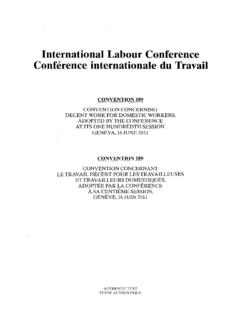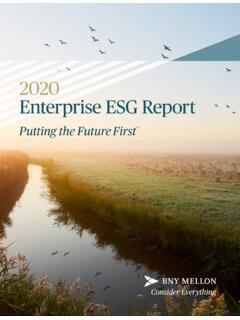Transcription of The MSME Sector At A Glance
1 At A Glance March 2012 AG-12-03 The MSME Sector Micro, small and medium enterprises (MSMEs) have a very important role in developing the Philippine economy. They help reduce poverty by creating jobs for the country s growing labor force. They stimulate economic development in rural and far-flung areas. They serve as valuable partners to large enterprises as suppliers and providers of support services. They serve as breeding ground for new entrepreneurs and large corporations. A vibrant MSME Sector is thus an indication of a thriving and growing economy. Despite policies that aim to provide an enabling environment for MSME development, the Sector still faces various constraints that prevent it from realizing its full growth and potential. Sector profile An MSME in the Philippines is defined as any business activity or enterprise engaged in industry, agri-business and/or services that has: (1) an asset size (less land) of up to PhP100 million; and (2) an employment size with less than 200 Based on these categories, it is classified as micro, small or medium (Table 1) regardless of the type of business ownership ( , single proprietorship, cooperative, partnership or corporation).
2 As of 2010, there were a total of 777,687 business enterprises in the Philippines. Of this figure, MSMEs represented percent with 774,664 establishments while large enterprises represented percent with 3,023 establishments. Micro enterprises comprised percent (709,899) of the total number of MSMEs while small and medium enterprises accounted for 8 percent (61,979) and percent (2,786), respectively. Overall, percent of MSMEs are engaged in the wholesale/retail trade and repair services with 384,746 business establishments while percent (111,366) and percent (96,989) are in the manufacturing and hotels/restaurants industries, respectively (Figure 1). MSMEs in real estate, renting and business activities represent percent (47,569), and those involved in other community, social and personal service activities account for percent (44,209).
3 Other MSMEs ( ) are engaged in health and social work (31,547); financial intermediation (26,350); education (13,930); transport storage and communications (9,010); agriculture, hunting and forestry (3,829); construction (2,292); electricity, gas and water (1,307); fishing (1,126); and mining and quarrying (394). In terms of employment generation, MSMEs provided a total of 3,532,935 jobs2 in 2010 or of the total jobs generated by all types of business establishments. Large enterprises generated 2,136,362 jobs. Among MSMEs, 1 Based on the definition under Republic Act No. 9501 or the Magna Carta for MSMEs, which amended RA 8289 and RA 6977 (Magna Carta for Small Enterprises); and on the establishment category used by the National Statistics Office (NSO), respectively.
4 2 Refers to actual total employment of establishments included in NSO s 2010 List of Establishments; and is different from the employment statistics generated from the Labor Force Survey. Table 1: MSME Classification enterprise Category By Asset Size By Number of Employees Micro Up to P3,000,000 1 - 9 employees Small P3,000,001 - P15,000,000 10 - 99 employees Medium P15,000,001 - P100,000,000 100 - 199 employees Figure 1. Percentage Distribution of MSMEs by Industry, 2010 Source: 2010 List of Establishments, NSO micro enterprises created 1,729,100 ( ) jobs while small and medium enterprises generated 1,417,672 (25%) and 386,163 ( ) jobs, respectively. MSME employment by industry generally follows the same structure as the number of establishments per industry, with MSMEs engaged in the wholesale and retail trade generating 1,237,917 jobs in 2010 followed by 617,634 jobs in manufacturing, and 479,668 jobs in hotels and restaurants (Table 2).
5 In terms of regional distribution, the top five regions with the most number of MSME establishments and MSME employment are: (1) National Capital Region (NCR) with 209,223 establishments and 1,324,847 jobs; (2) Region 4-A (CALABARZON Cavite, Laguna, Batangas, Rizal, Quezon) with 113,859 establishments and 459,564 jobs; (3) Region 3 (Central Luzon) with 79,019 establishments and 312,507 jobs; (4) Region 7 (Central Visayas) with 45,322 establishments and 232,408 jobs; and (5) Region 6 (Western Visayas) with 45,176 establishments and 188,932 jobs. Figure 2 shows that the regional distribution of MSMEs is in line with economic activity or income level distribution as estimated by the gross regional domestic product (GRDP). Despite representing an array of industries and its capacity to generate employment, the MSME Sector in the Philippines has relatively low value added to the economy.
6 The Department of Trade and Industry estimated that MSMEs in the country contribute only percent of value added, lower than in other Asian economies such as Indonesia ( ), Vietnam (39%) and Thailand ( ). Barriers to MSME Growth and Development The constraints that MSMEs often face can generally be categorized as: (1) non-financial barriers (cost of getting electricity, heavy regulation, high tax rates, and corruption); and (2) financial barriers (access to finance). Based on the World Bank s indicators on the ease of doing business, the Philippines lags behind its neighboring countries in reducing the number of start-up procedures, cost to start a business (measured in terms of percent of gross national income per capita or GNI pc), and number of tax payments per year (Table 3).
7 These non-financial barriers to MSME development translates to high cost of doing business or poor business environment, and discourages the formation of new MSMEs or the entry of existing MSMEs into larger markets, among others. Other countries with lower costs of doing business have been observed to have larger MSME sectors. Figure 2: Distribution of MSMEs by Region vs Regional Contribution to Philippine GDP Sources: 2010 List of Establishments, NSO and 2009 GRDP, National Statistical Coordination Board (NSCB) MICROSMALLMEDIUM MSMEsLARGET otalAgri cul ture, Hunti ng and Fores try9,855 31,213 16,515 57,583 81,594 139,177 Fi s hi ng3,408 5,705 4,377 13,490 14,227 27,717 Mi ni ng and Quarryi ng930 3,878 1,960 6,768 21,201 27,969 Manufacturi ng259,204 244,156 114,274 617,634 685,410 1,303,044 El ectri ci ty, Gas and Water2,608 20,924 17,086 40,618 56,397 97,015 Cons tructi on5,305 27,781 17,391 50,477 92,819 143,296 Whol es al e/Retai l Trade.
8 Repai r Servi ces816,095 364,164 57,658 1,237,917 139,032 1,376,949 Hotel s and Res taurants233,525 224,963 21,180 479,668 22,883 502,551 Trans port Storage and Communi cati ons26,161 49,399 16,671 92,231 106,331 198,562 Fi nanci al Intermedi ati on80,706 85,395 12,377 178,478 152,970 331,448 Real Es tate, Renti ng and Bus i nes s Acti vi ti es109,214 122,428 46,104 277,746 578,239 855,985 Educati on31,516 154,515 37,695 223,726 98,770 322,496 Heal th and Soci al Work51,006 35,240 15,615 101,861 57,000 158,861 Other Communi ty Soci al and Pers onal Servi ce Acti vi ti es99,567 47,911 7,260 154,738 29,489 184,227 Total1,729,100 1,417,672 386,163 3,532,935 2,136,362 5,669,297 Source: 2010 List of Establishments, NSOI ndustryTable 2.
9 Number of Employees by Industy and Firm Size, 2010No. of Employees On the other hand, the lack of access to financing has been identified as the most serious constraint to MSME growth and development. Financing, particularly from external sources such as banks, becomes more important as firms start expanding. Though funds have been made available by government financial institutions (Table 4) and private banks, most MSMEs still have difficulty accessing these funds because of: (1) insufficient collateral, limited credit histories and banking relation-ships; (2) inadequate financial records and business plans; and (3) high interest rates. MSMEs would thus tend to rely on informal non-banking channels for financing support (NEDA, 2010).
10 On mandatory lending to MSMEs, the Bangko Sentral ng Pilipinas (BSP) reported the over-compliance of banks on the provision of the law to allocate portions of total loan portfolio to Total bank loans to MSMEs have exceeded the mandatory allocation by an average of percent (PhP117 billion) from 1991 to 2010 (Figure 3). It has been noted, however, that the bank compliance report does not represent the real situation in bank lending to MSMEs; and that the BSP data represent an aggregate figure and do not show individual bank performance (Lagua, 2012). It would also seem that few MSMEs are benefitting from these bank loans given that only percent of all Philippine enterprises (Table 5) have been estimated to have access to financing from formal financial institutions.








